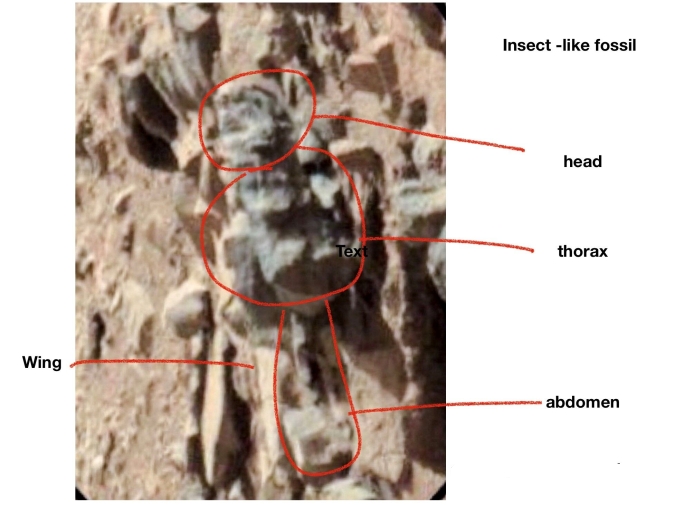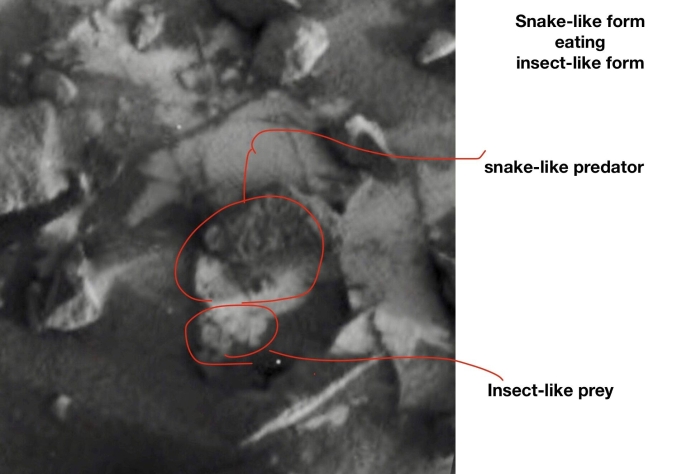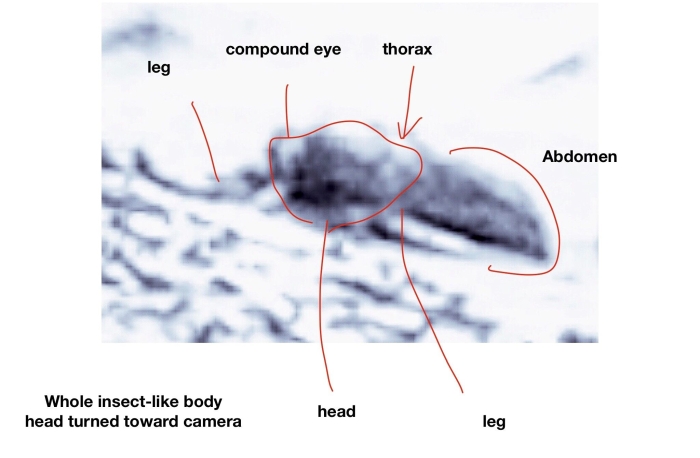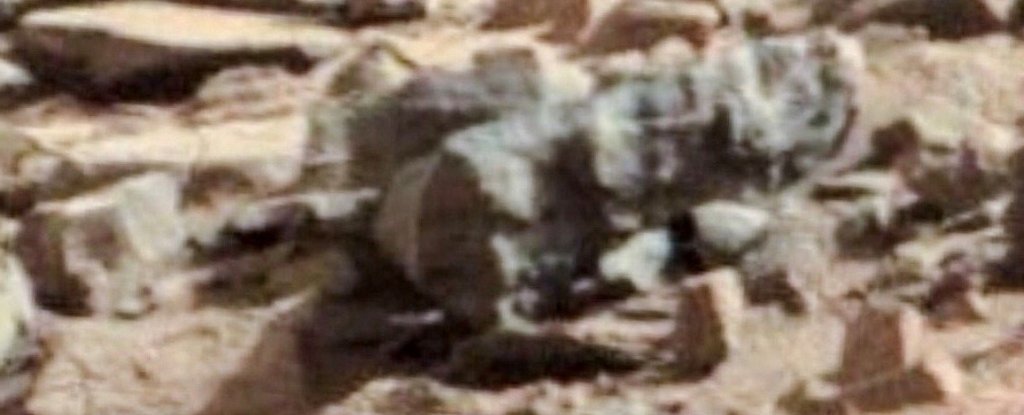(Michelle Starr) The search for evidence of microbial life on Mars – whether fossil or extant – is ramping up, and it’s even being included in the mission statements of future Mars missions. According to one scientist, though, we may have already found life on Mars, and it’s not titchy microbes, but strapping great bugs.
by Michelle Starr, November 20th, 2019
Entomologist William Romoser of Ohio University has spent years poring over publicly released photos taken by Mars rovers, and he says that many of them show structures that look a heck of a lot like insects, in among the rocks – fossilised as well as living.
And he’s even spotted a few things that look like snakes. This body of evidence is, he said, a good justification for investigating further. He presented his findings, which have not been peer-reviewed, at the Entomological Society of America annual meeting in St Louis. You can view the full poster here.
“There has been and still is life on Mars,” Romoser claims.
“There is apparent diversity among the Martian insect-like fauna which display many features similar to Terran insects that are interpreted as advanced groups – for example, the presence of wings, wing flexion, agile gliding/flight, and variously structured leg elements.”
Related Secret Mars: The Alien Connection [NASA Can’t Keep this Secret]
[the_ad_group id=”3117″]
Photos from the Mars rovers – particularly Curiosity, which is the only rover still active after Opportunity met its sad fate in the form of a colossal sandstorm last year – are publicly released, and they show detailed views of the surface of Mars. Geologists can study these to try and understand the planet’s geological history.
 (NASA/JPL; William Romoser/Ohio University)
(NASA/JPL; William Romoser/Ohio University)
It’s in these photos that Romoser has spotted his bugs. Many of the photos, he says, show evidence of insects – of carapaces, legs, wings, antennae and segmented bodies that seem distinct from the surrounding regolith.
He has made a careful visual examination of each photo, choosing those that show the forms most similar to insects. Criteria include a dramatic difference from surrounding rock, clarity and symmetry, segmentation, skeletal remains and groupings of more than one form.
He also took certain poses, evidence of motion or flight, apparent interaction with other forms, and apparently shiny eyes as evidence that the insect or snake might be alive.
[the_ad_group id=”3136″]
“Once a clear image of a given form was identified and described, it was useful in facilitating recognition of other less clear, but none-the-less valid, images of the same basic form,” Romoser says.
However, there is another possibility: that the things identified by Romoser as insects are just… rocks.
 (NASA/JPL; William Romoser/Ohio University)
(NASA/JPL; William Romoser/Ohio University)
Humans who’ve been staring at pictures of Mars have a well-known history of a phenomenon called pareidolia. That’s when you look at something and see something else: when the human mind, searching for meaning in meaningless data, sees something that isn’t there.
It may be a face in a power socket. Or a face in a landscape (it’s usually faces. Face perception is pretty important for humans, social beasts that we are). Or a face on Mars, like the famous picture of a region called Cydonia on Mars, taken in 1976.
Buy Book Death on Mars: The Discovery of a Planetary Nuclear Massacre
[the_ad_group id=”3116″]
There’s also been the Mars Bigfoot, the Mars cannonball, the Mars spoon, the Mars warrior woman and the Mars “Assyrian god”. They all turned out to be normal, ordinary Mars rocks.
We’ve been sending missions to Mars since the 1960s, including four successful rovers and five successful landers, and there has never been a confirmed sighting – or, indeed, any sighting put forward by an actual scientist – of any type of insect on Mars.
So it’s entirely possible is that Romoser, who worked as an entomology professor for 45 years, and whose insect perception is perhaps more acutely tuned than that of the average human, is experiencing insect-related pareidolia.

(NASA/JPL; William Romoser/Ohio University)
Whether he’s right or wrong, though, we may not have to wait too long for the answer. The Mars 2020 mission, equipped with more advanced equipment than Curiosity, is due to launch next year, reaching Mars in early 2021.
Part of its mission will involve the search for life on Mars. If there are bugs, maybe Mars 2020 will find them.
Meanwhile, Romoser advises a closer look at the photos he has identified.
“While any given image does not in itself prove anything, I believe the mosaic of what I have described is compelling,” he wrote in his abstract.
“I view the research reported here to be replicative and corroborative. It is very clear that much more study of the photos is needed.”
Romoser presented his research at Entomology 2019.
Buy Book When Giants Were Upon the Earth: The Watchers, The Nephilim, and the Cosmic War of the Seed
[the_ad_group id=”3115″]
Stillness in the Storm Editor: Why did we post this?
The preceding information presents information that builds a case for the existence of extraterrestrial life in the universe, which some claim has already made contact with humanity. While these claims remain largely unconfirmed, in a substantive and comprehensive way, an individual can contemplate their meaning, and in the process, catalyze the mind for greater awakening. This information also helps dispel the false reality pushed by the Deep State, which is essential so as to liberate the individual from the fetters of disillusionment related fundamentally myopic and depreciated view of cosmic realities and ultimate identities.
– Justin
Not sure how to make sense of this? Want to learn how to discern like a pro? Read this essential guide to discernment, analysis of claims, and understanding the truth in a world of deception: 4 Key Steps of Discernment – Advanced Truth-Seeking Tools.
Stillness in the Storm Editor’s note: Did you find a spelling error or grammar mistake? Send an email to corrections@stillnessinthestorm.com, with the error and suggested correction, along with the headline and url. Do you think this article needs an update? Or do you just have some feedback? Send us an email at sitsshow@gmail.com. Thank you for reading.
Source:
https://www.sciencealert.com/an-entomologist-is-trying-to-convince-us-that-mars-is-covered-in-bugs

Leave a Reply